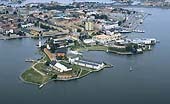The U.S. Navy has hit back at its critics with a staunch defence of the Littoral Combat Ship (LCS) programme. Lt Robert Myers, a Pentagon spokesman for the Navy, charged that critics have rounded on the LCS because of outdated perspectives, stressing that the versatility of the ship is a formidable strength.
An uncertain future
Making the case for the LCS, Lt Myers said he was unsurprised by criticism because it was a “new concept, and people are generally sceptical towards things that are new.” Speaking about the Navy’s new clout, he described the LCS as “like having another tool in the toolbox,” which will provide the U.S. Navy with unprecedented presence and operational capability.
While he was adamant the LCS programme met requirements, he admitted uncertainty within the Navy about its future. He said the Navy has assembled a taskforce to evaluate its development, with deliberations currently taking place amongst the naval leadership before their findings are presented to Secretary of Defense Chuck Hagel
“We could continue with the LCS as it is, it could be modified, or it could be something entirely different,” Lt Myers admitted.
Lt Myers was insistent that Hagel’s decision was not the death knell for the LCS, but rather a reflection of the tight budgetary constraints and an acknowledgement that the LCS is a “first attempt” at an entirely new class of ships.
The Navy has been reticent to accept the criticism though, despite acceptance that the LCS faces an uncertain future. Lt Myers explained the inevitability of the criticism, noting that early teething problems had unfairly clouded the debate. He added that LCS USS Freedom had been deployed early as part of a drive to “test and explore capabilities.” Lessons from the Freedom’s ten month tour, which included offering humanitarian assistance in the Philippines, had provided valuable lessons.
The “big picture”
“They’re not looking at the big picture,” Lt Myers said of his critics. “[LCS] gives us capability to operate in environments we didn’t previously have the capability to operate in.”
He also argued the economic case.
“What are we asking the ships to do? Do you want to take a Destroyer than costs $1 billion and [undertake] maritime security operations with it, when you can have a ship that costs $400 million to do that?”
Rather than burdening Destroyers and Cruisers with maritime patrol or support operations, these platforms will be freed up to return to their primary roles.
The new class of LCSs are capable of operating closer to the shore and are equipped to ward off attacks from small, fast attack boats. This is crucial considering the Navy is tasked with combatting rising asymmetric threats, undertaking anti-piracy and anti-terror operations.
Lt Myers also played down suggestions of flaws in the ship’s defence, referring to a report he’d seen stating that the LCS could withstand anti-carrier mines. He said reports of LCS vulnerability were overstated, noting they were protected and armed “commensurate to the threat… [the LCS] is meant to encounter and the operations it is meant to execute.”
The LCS is based on a system of modulatory, which enables equipment to be swapped in and out dependent on the needs of the mission. A leaked naval report indicatedthat swapping modules could take three weeks, but Lt Myers suggested that such criticism was outdated, noting the success of recent trials in which modules were swapped within 96 hours. The modular system also allows technology to be upgraded over time, an innovation which will allow the ship to remain technologically up-to-date for the duration of its service, hoped to be around 30 years. This is a far more economical option than undertaking big, physical changes to the ship, which have previously been needed to implement upgrades, and also avoids having to remove the ship from service.
“Lockheed Martin is proud of our role in providing the U.S. Navy with the unique capabilities of the Littoral Combat Ship,” the spokesman confirmed via email. “Our Freedom class ships meet all the established requirements, and the LCS is a critical element of the Navy’s strategic plan. It is already proving its value to the Fleet.”
The future of the LCS programme lies in the hands of Chuck Hagel, who will have to assess whether LCS offers value for money or if the U.S. Navy’s answers lie elsewhere. In the meantime, fiscal restrictions will continue to shape the future of the US forces for years to come.
\
 |
| LCS 1 |
 |
| LCS 3 |


